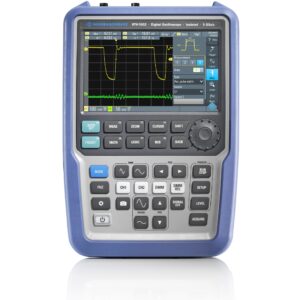Rohde & Schwarz says it has combined five instruments into one portable instrument that weighs a little more than five pounds. The handheld oscilloscope is said to operates like a tablet but with the performance of a lab instrument.

The new Scope Rider is claimed to have an acquisition rate of 50,000 waveforms per second, a max bandwidth of 500 megahertz for analog input channels and 33 automatic measurement functions. It is ruggedized, with an IP51 certified housing, and has a “large-format” capacitive touchscreen, the company said, as well as large buttons and a multifuction wheel that can be utilized with gloves on. Rohde & Schwarz said the Scope Rider can function as a logic analyzer, protocol analyzer, data logger (it supports microSD, USB and Ethernet) and a digital multimeter. It will be available in four-channel or two-channel models and will be demonstrated for the first time publicly next month at the Embedded World 2016 conference in Nuremburg, Germany.
–EXFO reported its most recent quarterly results this week, with sales at $55.2 million in its first fiscal quarter of 2016, down slightly from $56.7 million during the same period last year. Net earnings were $1.8 million for the quarter, up from $1.5 million in the year-ago period, and the company said bookings grew by nearly 8% year-over-year.
“The transformations implemented during fiscal 2015 are starting to pay off as demonstrated by the bookings growth of our two product groups, especially in North America and for our protocol-layer offering, which helped to generate our best gross margin in 15 quarters,” said Germain Lamonde, EXFO’s chairman, president and CEO, in a statement. “Given the impact of our transformations, completed cost reductions and favorable currency trends, I believe we are off to a good start to deliver or surpass our adjusted [earnings before interest, taxes, depreciation and amortization] target of $20 million for fiscal 2016.”
–PCTest Engineering Laboratory is using Anritsu’s ME7834L Mobile Device Test Platform for LTE data throughput testing, as defined in the PTCRB’s RFT 113. These include both static and dynamic fading scenarios across multiple LTE bands, the two companies said, and more than 60% of the test cases have been verified by PTCRB. Anritsu said dynamic fading tests are “forecast to accelerate in early 2016 with their expected addition to the PTCRB certification requirements.”
–Keysight Technologies says it has the industry’s first oscilloscope-based software for USB 3.1 Gen 2 10 Gbps protocol decoding for testing and troubleshooting. The Gen 2 interface encoding is “significantly more complex than previous versions,” Keysight said. The software also works with USB Type-C implementations of Gen 2, which the company said is drawing strong interest from its customers.
USB 3.1 is expected to boost the potential data transfer speed from 5 gigabits per second to 10 Gbps. As reported by Ars Technica, the USB 3.1 and Type-C connector technologies were floating around CES 2016 in a few places this week, and are expected to become more mainstream over the course of the next year.
Keysight also announced two new software solutions for examining signal integrity and power integrity in the context of link performance in printed circuitboard designs, both of which it plans to have on hand at DesignCon later this month.
–GL Communications launched a new, high-capacity analog bulk call generator for testing central office, PBXs, gateways and other telecom equipment. The MAPS Analog Phone Simulator is part of the company’s MAPS platform for testing a wide variety of telecom networks, and is scalable up to thousands of simulated calls.

